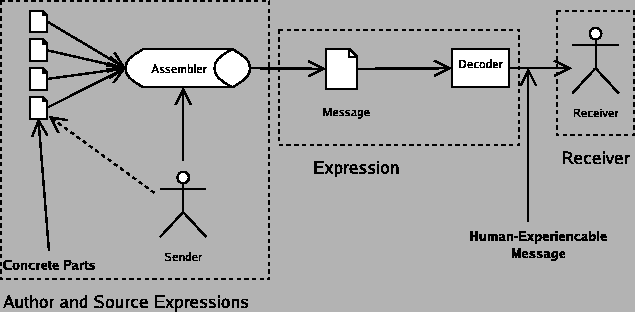 |
We can look at the old model in terms of the new model, both to better understand their differences, and where the old model fails to capture important nuances.
The old model can be seen as a special case of the new model, when the following conditions are true:
- The "final message" is static, not dynamic, so we need not consider the effects of assembly, which may change over time like dynamic webpages. We can assign all responsibility for that to the author. This collapses the box labelled "Author and Source Expressions" into just the author and the source expressions.
- The expression, having a concrete physical existence (as in the case of a book), is its own decoder and never changes, collapsing the box labelled "Expression" into the expression part of the original model.
The receiver of both models is the same, but note that "Human received message" is still outside of any box. The reason for this is that the human received message is simply not considered in the old model, despite its importance, because everything going into the human-received message is static, so it can be ignored.
But look at what the old model loses. It has no way to represent any of the fancy messages we discussed in "A Thousand Cuts". It can't handle programs that dynamically assemble things from other messages. It can't handle the impact of various web browsers ("decoders") on the message, because in the original expression model everything is intimately tied with its inherent physical representation.
As alluded to previously but not said directly, this model is still tolerably useful when the relationships are all static. For example, the individual article text for the stories CNN runs is still handled decently by the old model. They do not change over time and typically consist of some static set of quotes from sources, writing from CNN correspondants, and other such static material. Where the model breaks down is when programs start dynamically knitting the static parts together. It's impossible to handle the homepage of CNN.com as an expression because it's effectively impossible to nail down just what "the homepage of CNN.com" is. The concrete part and human-perception model works because the problem is broken down: Concrete parts (very similar to expressions) for the part of the message that works well on, and a human-perceived message for each individual experience of the homepage by a person. Separately, they can be treated sensibly.